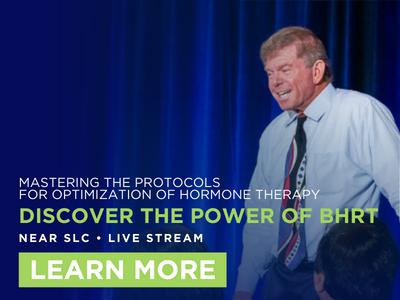
Make a Difference in Patient Wellness with Hormone Therapy

Make a Difference in Patient Wellness with Hormone Therapy
Have you experienced the frustration of a patient who never seems to get better?
You’ve diagnosed them with insulin resistance or even full-blown Type II Diabetes. You’ve counseled them on changing her diet. You’ve prescribed metformin to reduce glucose production in the liver. But on the next visit, their fasting blood glucose hasn’t changed or is even a bit higher. Their hemoglobin A1C isn’t budging. They lost a couple of pounds early on, but gained it back after a few weeks.
You’ve asked her how they are doing with changing the way they eat and they say, “I’m trying.”
Worst of all, your patient is clearly feeling discouraged. They are ready to give up. “What’s the use?”
If you’ve ever experienced this scenario, you’re not alone. This frustration comes up all the time in our discussions with providers at our BHRT Workshop Series.
Providers are Tired of Not Making a Difference
1. Nurse practitioner Beth York, from Nashville, TN, expressed her ongoing disappointment about her patients that never made any progress. She began to feel as though she was putting a Band-Aid on serious health issues, rather than truly moving patients toward health. She knew how to diagnose things like Type II Diabetes, but prescribing a medication and talking with the patient about lifestyle changes didn’t seem to be quite enough.
2. Nurse practitioner Karl Lambert, from Wenatchee, WA, had been seeing 20 to 30 patients a day. He wrestled with the feeling that he wasn’t making any difference in their lives. This suspicion was confirmed when he’d see them again, 6 months to a year after, and nothing had changed. Same symptoms, same lab results. See what he has to say:
Here’s The Good News!
You can make a difference.
It’s possible to start seeing patients improve their health, even patients with chronic diseases like diabetes and obesity that don’t seem to respond well to traditional treatments.
Providers who have trained with Dr. Neal Rouzier of Worldlink Medical have discovered a new paradigm in medical practice.
They’ve gone beyond the diagnosis of disease they’d been taught in medical school. They’ve started recognizing the impact that sub-optimal hormone levels can have on long-term health. These providers are looking at estradiol, progesterone, testosterone, thyroid hormones (T3 and T4, as well as TSH), DHEA, pregnenolone, melatonin, cortisol, and others.
They’ve discovered that getting these hormones back to “optimum” levels has a profound impact on whether patients make progress toward their health goals.
They’re also helping patients understand the benefits of diet and lifestyle changes that are much more effective when hormones have been optimized.
These practitioners are helping patients see the big picture of wellness and helping them feel better, lose weight, regain energy, and experience a fulfilling life.
Patient’s Body Fat Drops From 46% to 15% in Just 9 Months
New Jersey physician, Johanan Rand, MD describes his experience with a morbidly obese male patient. Presenting with chronic pain issues, the patient was objectively measured at 323 pounds and 46% body fat on Dr. Rand’s body composition machine. After optimizing the patient’s hormones, based on protocols taught at Worldlink Medical courses, and providing patient education, lifestyle management, and nutritional supplements, Dr. Rand saw the patient’s body composition dramatically improve, down to 15% after only 9 months.
Eliminating or Reducing Medications
Nurse Practitioner Teresa Mealy, from Springfield, MO, has experienced the power of looking at the big picture in patients struggling with diabetes, rather than simply looking at the disease process alone. In her practice, she optimizes all the patient’s hormones, deals with lifestyle issues, diet, exercise, nutritional support, and stress. She has several examples of patients who had been diagnosed with Type II Diabetes. Some of them have been able to eliminate or at least reduce the number of medications they were on after being on her holistic program for a time.
You’ll Never Want to Go Back to Sick Care
Karl Lambert would never want to go back to the “Sickness Model” of treating patients. The results he’s seeing have revitalized his passion for medicine. He’s even looking to approach companies with a proposal to help them with diabetic patients by getting them healthier.
Helping diabetics reverse their diabetes is something no one dreams of . . . until they find out it’s really possible.
If you’d like to learn more about the tools of hormone optimization these providers have used to make a difference for their patients, Part I: Discover the Power of BHRT from the four part series Mastering the Protocols for Optimization of Hormone Replacement Therapy is the best place to start.
Evidence Supporting Improved Outcomes With Optimal Hormones
-
- Heufelder AE, Saad F, Bunck MC, Gooren L. Fifty-two-week treatment with diet and exercise plus transdermal testosterone reverses the metabolic syndrome and improves glycemic control in men with newly diagnosed type 2 diabetes and subnormal plasma testosterone. J Androl. 2009;30(6):726–733. doi:10.2164/jandrol.108.007005
- English KM, Steeds RP, Jones TH, Diver MJ, Channer KS. Low-dose transdermal testosterone therapy improves angina threshold in men with chronic stable angina: A randomized, double-blind, placebo-controlled study. Circulation. 2000;102(16):1906–1911. doi:10.1161/01.cir.102.16.1906
- Shifren JL, Braunstein GD, Simon JA, et al. Transdermal testosterone treatment in women with impaired sexual function after oophorectomy. N Engl J Med. 2000;343(10):682–688. doi:10.1056/NEJM200009073431002
- Achilli C, Pundir J, Ramanathan P, Sabatini L, Hamoda H, Panay N. Efficacy and safety of transdermal testosterone in postmenopausal women with hypoactive sexual desire disorder: a systematic review and meta-analysis. Fertil Steril. 2017;107(2):475–482.e15. doi:10.1016/j.fertnstert.2016.10.028
- Salpeter SR, Cheng J, Thabane L, Buckley NS, Salpeter EE. Bayesian meta-analysis of hormone therapy and mortality in younger postmenopausal women. Am J Med. 2009;122(11):1016–1022.e1. doi:10.1016/j.amjmed.2009.05.021
- Sánchez-Rodríguez MA, Zacarías-Flores M, Castrejón-Delgado L, Ruiz-Rodríguez AK, Mendoza-Núñez VM. Effects of Hormone Therapy on Oxidative Stress in Postmenopausal Women with Metabolic Syndrome. Int J Mol Sci. 2016;17(9):1388. Published 2016 Aug 24. doi:10.3390/ijms17091388
- Rossi R, Origliani G, Modena MG. Transdermal 17-beta-estradiol and risk of developing type 2 diabetes in a population of healthy, nonobese postmenopausal women. Diabetes Care. 2004;27(3):645–649. doi:10.2337/diacare.27.3.645
- Smith NL, Blondon M, Wiggins KL, et al. Lower risk of cardiovascular events in postmenopausal women taking oral estradiol compared with oral conjugated equine estrogens [published correction appears in JAMA Intern Med. 2014 Sep;174(9):1523]. JAMA Intern Med. 2014;174(1):25–31. doi:10.1001/jamainternmed.2013.11074
- Casanova G, Spritzer PM. Effects of micronized progesterone added to non-oral estradiol on lipids and cardiovascular risk factors in early postmenopause: a clinical trial. Lipids Health Dis. 2012;11:133. Published 2012 Oct 9. doi:10.1186/1476-511X-11-133
- Janjgava S, Zerekidze T, Uchava L, Giorgadze E, Asatiani K. Influence of testosterone replacement therapy on metabolic disorders in male patients with type 2 diabetes mellitus and androgen deficiency. Eur J Med Res. 2014;19(1):56. Published 2014 Oct 23. doi:10.1186/s40001-014-0056-6
- Prestwood KM, Unson C, Kulldorff M, Cushman M. The effect of different doses of micronized 17beta-estradiol on C-reactive protein, interleukin-6, and lipids in older women. J Gerontol A Biol Sci Med Sci. 2004;59(8):827–832. doi:10.1093/gerona/59.8.m827
- Elliott J, Kelly SE, Millar AC, et al. Testosterone therapy in hypogonadal men: a systematic review and network meta-analysis. BMJ Open. 2017;7(11):e015284. Published 2017 Nov 16. doi:10.1136/bmjopen-2016-015284
- Traish AM, Guay A, Feeley R, Saad F. The dark side of testosterone deficiency: I. Metabolic syndrome and erectile dysfunction. J Androl. 2009;30(1):10–22. doi:10.2164/jandrol.108.005215
- Traish AM, Saad F, Guay A. The dark side of testosterone deficiency: II. Type 2 diabetes and insulin resistance. J Androl. 2009;30(1):23–32. doi:10.2164/jandrol.108.005751
- Traish AM, Saad F, Feeley RJ, Guay A. The dark side of testosterone deficiency: III. Cardiovascular disease. J Androl. 2009;30(5):477–494. doi:10.2164/jandrol.108.007245
- Yassin DJ, Doros G, Hammerer PG, Yassin AA. Long-term testosterone treatment in elderly men with hypogonadism and erectile dysfunction reduces obesity parameters and improves metabolic syndrome and health-related quality of life. J Sex Med. 2014;11(6):1567–1576. doi:10.1111/jsm.12523
